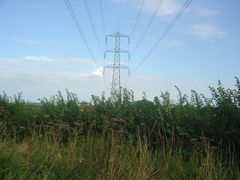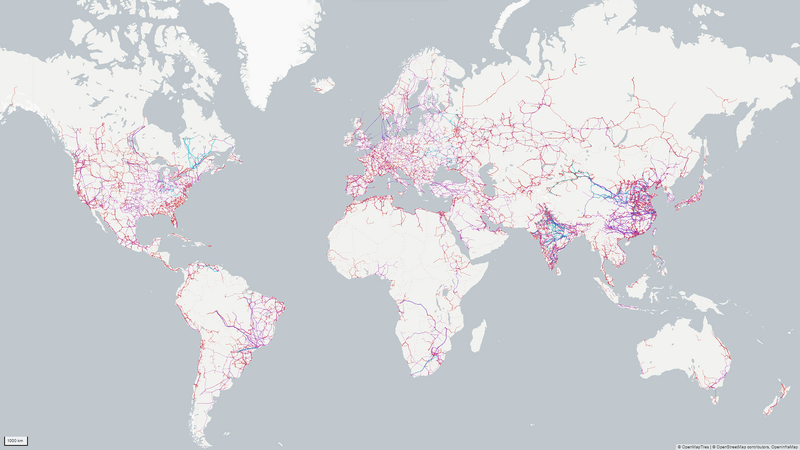Zh-hans:电力

|
| 说明 |
| 用于描述输电线和相关的基础设施。 |
| 组 |
| 标签 |
power=*(电力)标签用于识别与电力的产生和分配有关的各种设施和特征,包括输电线,发电机,塔架和变电站。电力网络提供了该项目的更多详细信息,以绘制配电图。
特征
This table is a wiki template with a default description in English. Editable here.
向导
非常有用的向导。
可以使用wires=single,wires=double或wires=quad标记每条电缆中的电线数量。所有输电塔顶端都架设着用来避雷的地线。
中国
法国
德国
参阅Power networks/Germany. The transmission network usually uses steel lattice pylons. There are three voltages:
- 380 kV: mostly triple or quadruple wires, historic lines may have double wires
- 220 kV: mostly double wires, historic lines may have single wires
- 110 kV subtransmission: single wires
Frequently, pylons carry multiple lines even at different voltages to save space.
The distribution network lines operate at 20 kV in most rural regions and are installed on wooden, concrete or small metal poles. 3 or 6 single wires, usually no ground wire. Single remote houses or farmyards may be supplied by 950 V lines of similar appearance.
Power lines showing 4 or 8 cables belong to the railway traction power network operated by DB Energie independently (110 kV two-phase, 16.7 Hz). Mostly single wires, rarely double or quadruple (at same voltage, increasing the possible current load).
日本
在日本,参阅User:Nahainec/PowerLine.
菲律宾
Further information at Power networks/Philippines
Power lines in the Philippines are operated by various companies and cooperatives. The National Grid Corporation of the Philippines (NGCP) operates both subtransmission (69 and 115 kV) and transmission lines (115 kV, 138 kV, 230 kV, 350 kV DC, and 500 kV), but utilities (e.g. Meralco, Visayas Electric Company, Davao Light) and electric cooperatives may operate subtransmission lines (69 or 115 kV) and distribution lines (usually 7.97/13.8 kV, or 20/34.5 kV). Some electric cooperatives only operate distribution lines, and depend on NGCP (or NAPOCOR-SPUG in areas not yet connected to NGCP grids) for subtransmission lines to feed their substations.
Power line locations may be on allocated right of way or along roads or railroads. Transmission lines usually run on separate right of way, but a few partially or completely running along roads or railroads. Subtransmission lines by NGCP typically run on separate right of way and some segments follow roads, but utility or cooperative-owned subtransmission lines are usually roadside, for easier access by work vehicles. Distribution lines are almost roadside and areas served by the lines are usually served by multiple distribution transformers (single-phase), like the common practice in most of Asia and the Americas. Smaller distribution substations (substation=minor_distribution) are primarily used on large users, like some government offices, malls, or condominiums, instead of a larger area, like residential areas, where multiple distribution transformers are used instead.
Voltages used are like those used in the United States, and the frequency is 60 Hz. The household voltage is 220 volts, 60 Hz, somehow double the 110/220 volts lines once used in the US, before it is raised to 115/230 volts and the current 120/240 volts, though people still refer them as 110 V volts. Standard voltages for power lines, follow this hierarchy, from low to high voltage, and further information can be seen in WikiProject Power networks/Philippines and User:TagaSanPedroAko/Philippines Tagging/Power lines.
Common grid voltages, with usual characteristics, are:
- 220 volts - secondary distribution. Can be two-wire (line and neutral, common in most provinces served by electric cooperatives and other utilities) or three-wire (two 110 V lines with neutral, commonly in areas served by private utilities, especially Meralco).
- 2,800/4,800 volts - one to three wires, carried on 9 meter and above poles. Transformers in these lines has primary bushings on the side of the transformers. This voltage, still used by Meralco, is being slowly phased out (through abandonment of lines or conversion of lines for the 34.5 kV level), to eliminate the need of additional substations or equipment to provide the voltage level to the end customers.
- 7,620/13,200 volts (or 7970/13800 volts, by Meralco, in northern Bulacan, southern Cavite, parts of Laguna, and Batangas City and San Pascual in Batangas) - one to three wires, placed on poles 9 meters or above in height. Lines uses insulators of about 15 centimeters in length. Transformers on such lines usually feature two bushings, but the other bushing is rather part of the grounding mechanism, providing 220 volts directly on two-wire lines. Lines by Meralco, Cabanatuan Electric Corporation (CELCOR), and First Bay Power Corporation (in Bauan, Batangas) use both bushings, thus, they supply 110*2 split-phase voltage. This voltage is most used by most electric cooperatives in the Philippines, as well as by most utilities.
- 20,000/34,500 volts - one to three wires, usually in poles 12 meters and above in height. Lines of these voltage uses transformers with only one bushing, and uses insulators of about 35 or 45 centimeters in length. This voltage is usually used by Meralco, but also used by Cagayan Electric Power and Light Company (CEPALCO) in Cagayan de Oro (though the common voltage used is 7.62/13.2 kV, fed by the 69 kV network).
- 69,000 volts - three-wire system, usually without a neutral, that uses poles 15 meters and above in height, and uses 70 to 75 centimeter insulators (pole mounted, suspension-type, strain-type, and rarely, pin-type). 230,000 kV-designed steel poles, however, are rarely used. Considered a subtransmission voltage, and connects to larger customers and the primary distribution systems. Mostly used by the National Grid Corporation of the Philippines, but also used by some electric cooperatives and utilities.
- 115,000 volts - three wire system, with or without neutral, either on poles or towers, and uses 1.2 meter insulators (pole mounted, suspension-type, and strain-type) Usually found in Meralco's coverage area, but also used by the National Grid Corporation of the Philippines, especially its transmission lines that connect to the wind farms in Ilocos Norte.
- 138,000 volts - three wire systems (single or double circuit), on towers or steel poles with insulators of approximately 1.4 to 1.5 meters in length. Considered a regional transmission voltage in Visayas and Mindanao.
- 230,000 volts - three wire systems (single or double circuit), on towers or steel poles with insulators of approximately 2.3 to 2.4 meters in length. Considered a regional transmission voltage in Luzon, but also used in Visayas and Mindanao as bulk transmission voltages (to complement the 138 kV systems there). Lines usually have one conductor, but may be bundled to two, three, or four for additional capacity or efficiency (to mitigate power loss from corona discharges)
- 350,000 volts - two-wire systems (single circuit), on towers. Used on HVDC Leyte-Luzon transmission line, and has triple-bundle conductor (to mitigate power loss from corona discharges). On San Bernardino Strait between Cabacungan in Allen, Samar and Santa Magdalena in Sorsogon Province, Luzon, the line uses submarine cables.
- 500,000 volts - three wire systems (single or double circuit), on towers, or rarely, steel poles with insulators of approximately 5 to 5.1 meters in length. Considered a bulk transmission voltage in Luzon, and has a high carrying capacity, through the use of quadruple-bundle conductor (to provide more capacity and mitigate corona discharges).
Transmission, subtransmission, and distribution grid voltages, however, differ by island group, region, and company/cooperative practice.
- Metro Manila and nearby provinces in Luzon (Meralco):
- Transmission: 500,000 volts, 230,000 volts,
- Subtransmission 115,000 volts, 69,000 volts (northern Bulacan and Batangas City
- Distribution: 34,500 volts/20,000 volts (most of Meralco's coverage area), 13,800 volts/7,970 volts (Batangas City and San Pascual, both in Batangas)
- Household distribution: 110/220 volts (three wire split-phase)
- Most of Luzon:
- Transmission: 500,000 volts, 230,000 volts
- Subtransmission: 69,000 volts
- Distribution: 13,800 volts, 7970 volts
- Household distribution: 220 volts (single phase)
- Ilocos Region:
- Transmission: 230,000 volts, 115,000 volts
- Subtransmission: 69,000 volts
- Distribution: 13,800 volts, 7970 volts
- Visayas
- Transmission: 230,000 volts, 138,000 volts
- Subtransmission: 69,000 volts
- Distribution: 13,800 volts, 7,970 volts
- Household distribution: 220 volts (single phase)
- Mindanao
- Transmission: 230,000 volts (for implementation in the near future), 138,000 volts (current voltage, including the transmission backbone)
- Subtransmission: 69,000 volts
- Distribution: 34,500 volts/20,000 volts (Cagayan de Oro only), 13,800 volts, 7,970 volts
- Household distribution: 220 volts (single phase) (110/220 volts use in Mindanao not known)
英国
参阅Power networks/Great Britain。
美国
The number of conductors (i.e. single, double, triple) is simply relevant to the current handling capacity, and not more or less likely to be seen for any particular voltage. Similarly, the number of 3-phase circuits (groups of 3 cables) is simply a matter of capacity required, since single-circuit paths are (somewhat surprisingly) much cheaper to construct - the cost of the cables themselves apparently being the most significant factor.
渲染
Open Infrastructure Map渲染电力,电信,水,石油和微波通信基础设施,在其图层之一中还具有类似的电力线渲染功能,变电站名称及其最高电压,并标出了发电厂。电力线和电缆的电压渲染类似于ITO Map的电力覆盖图,现已废止。

另一种可视化可见于Flosm.de。
乌克兰部分地区的另一种可视化效果可见于nadoloni.com。
MapCSS样式
地图层叠样式表stylesheet可用于JOSM。